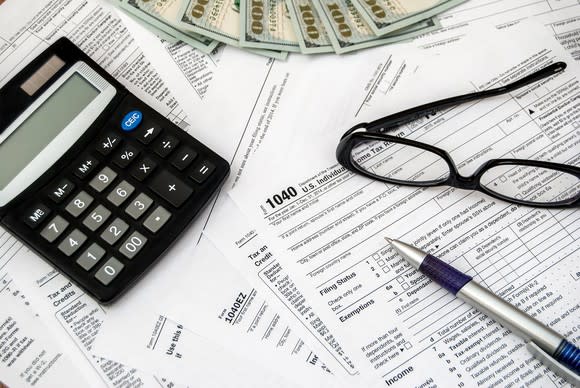How Much Will Tax Reform Boost Your Paycheck in 2018?
The tax reform bill that just became law late last year won't show up on your tax returns until you file in 2019. But workers are about to see the immediate impact of the bill in their paychecks, because the IRS just released its new withholding tables for 2018 that take tax reform into account.
Calculating withholding is a complicated procedure that requires taking several different things into account. A look at some simple examples for people in common situations can give you a better sense of what impact you're likely to see in your paycheck.
Single person, no children, $25,000 in earnings
For those who are just starting out or have a fairly low-paying job, the biggest part of tax reform was the increase in the standard deduction. You'd therefore expect less tax to get withheld from the paycheck of a single person with no dependents.
To calculate withholding, you first need to know how many withholding allowances are allowed. For most single people with no children, one withholding allowance is appropriate. In 2017, that reduced average weekly earnings of $480.77 by $77.90, and the remaining $402.87 produced withholding of $44.83 per week.
In 2018, the value of the withholding allowance goes up to $79.80, and different rates apply to the remaining $400.97. The result of running the numbers through the new formula is $35.94 per week. That will give the typical worker about a $9 weekly rise in take-home pay, or $462 over the course of a 52-week year.

Image source: Getty Images.
Married person, two children, $75,000 in earnings
Families saw a number of impacts in the tax reform package. Higher standard deductions were offset by lost personal exemptions. However, higher child tax credits also apply going forward. Overall, it wasn't clear what the impact on every married couple would be, even under simplified assumptions involving just taking the standard deduction. Such a family would often get four withholding allowances.
For 2017, using the tables for someone who gets paid twice a month, earnings of $3,125 per pay period would get reduced by $168.80 multiplied by four withholding allowances, resulting in $2,449.80. Run that through the brackets, and tax withheld would add up to $274.57 per pay period.
Under 2018 rules, withholding allowances for those paid twice a month are worth $172.90 each, making the after-allowance pay $2,433.40. The new formula produces $218.40 in withholding under those assumptions. That $56 difference adds up to almost $1,350 over the course of 24 pay periods in a year.
Single head of household, one child, $300,000 in earnings
Many people criticized tax reform because they saw it as being unfairly weighted toward helping high-income people. The withholding tables bear this out, at least in the size of the tax benefit that they produce.
Assuming two withholding allowances, someone in this situation who got paid monthly in 2017 would have had earnings of $25,000 reduced by a total of $675 for the two allowances. The remaining $24,325 would have resulted in monthly tax withholding of $6,580.55.
In 2018, the same person would get withholding allowances worth a total of $691.60. Running the remaining $24,308.40 through the new formula, you'd get withholding of $6,374.25. The monthly difference of $206 adds up to about $2,475 in tax savings -- larger than for the lower-income examples, but not as big a disparity as one might have initially expected.
Keep this important thing in mind
Withholding tables are made for general use, but they don't always do a good job of predicting what your actual tax liability will be. Although the Trump administration said that it expects the same proportion of people to claim refunds as did before, the amount that these withholding tables take out of your paycheck might lead to a much different-sized refund than you'll receive in a few months after you file your 2017 tax return.
Also, tax reform is so new that the IRS hasn't yet been able to update its Form W-4, which is the form you complete as an employee to figure the proper number of withholding allowances to take based on your specific situation. New W-4s are expected later this year, and it will be important for you to take the initiative and fill a new one out for your withholding to be correct.
Everyone likes getting a bigger paycheck, and the new withholding tables will generally deliver. You'll have to wait until early 2019, however, to see what the overall impact was -- and whether some of your larger take-home pay actually came at the expense of next year's tax refund.
More From The Motley Fool
The Motley Fool has a disclosure policy.

